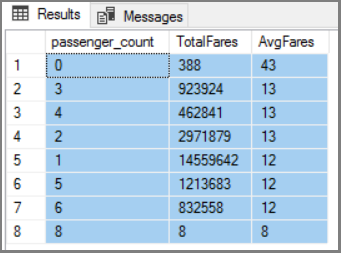หมายเหตุ
การเข้าถึงหน้านี้ต้องได้รับการอนุญาต คุณสามารถลอง ลงชื่อเข้าใช้หรือเปลี่ยนไดเรกทอรีได้
การเข้าถึงหน้านี้ต้องได้รับการอนุญาต คุณสามารถลองเปลี่ยนไดเรกทอรีได้
Applies to:
SQL Server 2016 (13.x) and later
Azure SQL Managed Instance
This article explains how to set up a sample database consisting of public data from the New York City Taxi and Limousine Commission. This data is used in several R and Python tutorials for in-database analytics on SQL Server. To make the sample code run quicker, we created a representative 1% sampling of the data. On your system, the database backup file is slightly over 90 MB, providing 1.7 million rows in the primary data table.
To complete this exercise, you should have SQL Server Management Studio (SSMS) or another tool that can restore a database backup file and run T-SQL queries.
Tutorials and quickstarts using this data set include the following articles:
- Learn in-database analytics using R in SQL Server
- Learn in-database analytics using Python in SQL Server
Download files
The sample database is a SQL Server 2016 backup (.bak) file hosted by Microsoft. You can restore it on SQL Server 2016 and later. File download begins immediately when you open the link.
File size is approximately 90 MB.
Note
To restore the sample database on SQL Server Big Data Clusters, download NYCTaxi_Sample.bak and follow the directions in Restore a database into the SQL Server big data cluster master instance.
Note
To restore the sample database on Machine Learning Services in Azure SQL Managed Instance, follow the instructions in Quickstart: Restore a database to Azure SQL Managed Instance using the NYC Taxi demo database .bak file: https://aka.ms/sqlmldocument/NYCTaxi_Sample.bak.
Download the NYCTaxi_Sample.bak database backup file.
Copy the file to
C:\Program files\Microsoft SQL Server\MSSQL-instance-name\MSSQL\Backupor similar path, for your instance's defaultBackupfolder.In SSMS, right-click Databases and select Restore Files and File Groups.
Enter
NYCTaxi_Sampleas the database name.Select From device and then open the file selection page to select the
NYCTaxi_Sample.bakbackup file. Select Add to selectNYCTaxi_Sample.bak.Select the Restore checkbox and select OK to restore the database.
Review database objects
Confirm the database objects exist on the SQL Server instance using SQL Server Management Studio. You should see the database, tables, functions, and stored procedures.

Objects in NYCTaxi_Sample database
The following table summarizes the objects created in the NYC Taxi demo database.
| Object name | Object type | Description |
|---|---|---|
| NYCTaxi_Sample | database | Creates a database and two tables:dbo.nyctaxi_sample table: Contains the main NYC Taxi dataset. A clustered columnstore index is added to the table to improve storage and query performance. The 1% sample of the NYC Taxi dataset is inserted into this table.dbo.nyc_taxi_models table: Used to persist the trained advanced analytics model. |
| fnCalculateDistance | scalar-valued function | Calculates the direct distance between pickup and dropoff locations. This function is used in Create data features, Train and save a model and Operationalize the R model. |
| fnEngineerFeatures | table-valued function | Creates new data features for model training. This function is used in Create data features and Operationalize the R model. |
Stored procedures are created using R and Python script found in various tutorials. The following table summarizes the stored procedures that you can optionally add to the NYC Taxi demo database when you run script from various lessons.
| Stored procedure | Language | Description |
|---|---|---|
| RxPlotHistogram | R | Calls the RevoScaleR rxHistogram function to plot the histogram of a variable and then returns the plot as a binary object. This stored procedure is used in Explore and visualize data. |
| RPlotRHist | R | Creates a graphic using the Hist function and saves the output as a local PDF file. This stored procedure is used in Explore and visualize data. |
| RxTrainLogitModel | R | Trains a logistic regression model by calling an R package. The model predicts the value of the tipped column, and is trained using a randomly selected 70% of the data. The output of the stored procedure is the trained model, which is saved in the table dbo.nyc_taxi_models. This stored procedure is used in Train and save a model. |
| RxPredictBatchOutput | R | Calls the trained model to create predictions using the model. The stored procedure accepts a query as its input parameter and returns a column of numeric values containing the scores for the input rows. This stored procedure is used in Predict potential outcomes. |
| RxPredictSingleRow | R | Calls the trained model to create predictions using the model. This stored procedure accepts a new observation as input, with individual feature values passed as in-line parameters, and returns a value that predicts the outcome for the new observation. This stored procedure is used in Predict potential outcomes. |
Query the data
As a validation step, run a query to confirm the data was uploaded.
In Object Explorer, under Databases, right-click the NYCTaxi_Sample database, and start a new query.
Run some basic queries:
SELECT TOP(10) * FROM dbo.nyctaxi_sample; SELECT COUNT(*) FROM dbo.nyctaxi_sample;
The database contains 1.7 million rows.
Within the database is a
dbo.nyctaxi_sampletable that contains the data set. The table has been optimized for set-based calculations with the addition of a columnstore index. Run this statement to generate a quick summary on the table.SELECT DISTINCT [passenger_count] , ROUND (SUM ([fare_amount]),0) as TotalFares , ROUND (AVG ([fare_amount]),0) as AvgFares FROM [dbo].[nyctaxi_sample] GROUP BY [passenger_count] ORDER BY AvgFares DESC
Results should be similar to those showing in the following screenshot.

Next steps
NYC Taxi sample data is now available for hands-on learning.